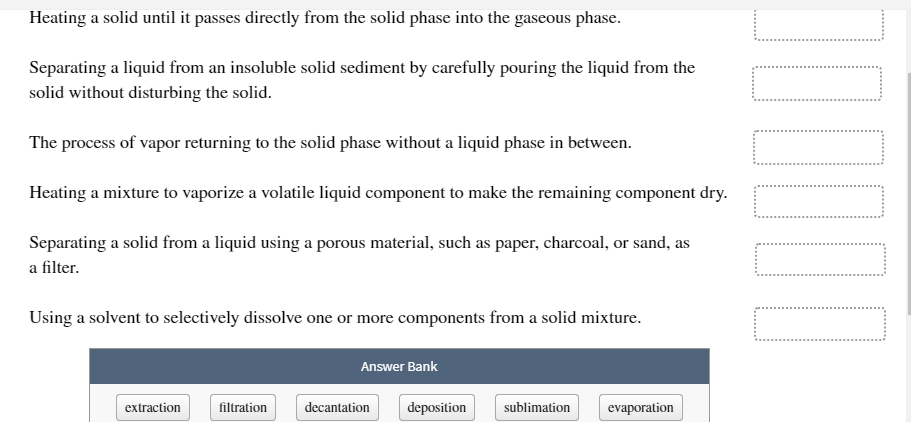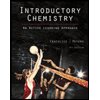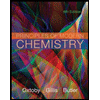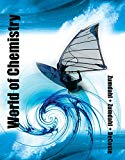Heating a solid until it passes directly from the solid phase into the gaseous phase. Separating a liquid from an insoluble solid sediment by carefully pouring the liquid from the solid without disturbing the solid. The process of vapor returning to the solid phase without a liquid phase in between. Heating a mixture to vaporize a volatile liquid component to make the remaining component dry. Separating a solid from a liquid using a porous material, such as paper, charcoal, or sand, as a filter. Using a solvent to selectively dissolve one or more components from a solid mixture. Answer Bank extraction filtration decantation deposition sublimation evaporation
Heating a solid until it passes directly from the solid phase into the gaseous phase. Separating a liquid from an insoluble solid sediment by carefully pouring the liquid from the solid without disturbing the solid. The process of vapor returning to the solid phase without a liquid phase in between. Heating a mixture to vaporize a volatile liquid component to make the remaining component dry. Separating a solid from a liquid using a porous material, such as paper, charcoal, or sand, as a filter. Using a solvent to selectively dissolve one or more components from a solid mixture. Answer Bank extraction filtration decantation deposition sublimation evaporation
Introductory Chemistry: An Active Learning Approach
6th Edition
ISBN:9781305079250
Author:Mark S. Cracolice, Ed Peters
Publisher:Mark S. Cracolice, Ed Peters
Chapter16: Solutions
Section: Chapter Questions
Problem 16.3TC
Related questions
Question

Transcribed Image Text:Heating a solid until it passes directly from the solid phase into the gaseous phase.
Separating a liquid from an insoluble solid sediment by carefully pouring the liquid from the
solid without disturbing the solid.
The process of vapor returning to the solid phase without a liquid phase in between.
Heating a mixture to vaporize a volatile liquid component to make the remaining component dry.
Separating a solid from a liquid using a porous material, such as paper, charcoal, or sand, as
a filter.
Using a solvent to selectively dissolve one or more components from a solid mixture.
Answer Bank
extraction
filtration
decantation
deposition
sublimation
evaporation
Expert Solution
This question has been solved!
Explore an expertly crafted, step-by-step solution for a thorough understanding of key concepts.
This is a popular solution!
Trending now
This is a popular solution!
Step by step
Solved in 2 steps with 1 images

Knowledge Booster
Learn more about
Need a deep-dive on the concept behind this application? Look no further. Learn more about this topic, chemistry and related others by exploring similar questions and additional content below.Recommended textbooks for you

Introductory Chemistry: An Active Learning Approa…
Chemistry
ISBN:
9781305079250
Author:
Mark S. Cracolice, Ed Peters
Publisher:
Cengage Learning

Principles of Modern Chemistry
Chemistry
ISBN:
9781305079113
Author:
David W. Oxtoby, H. Pat Gillis, Laurie J. Butler
Publisher:
Cengage Learning

World of Chemistry, 3rd edition
Chemistry
ISBN:
9781133109655
Author:
Steven S. Zumdahl, Susan L. Zumdahl, Donald J. DeCoste
Publisher:
Brooks / Cole / Cengage Learning

Introductory Chemistry: An Active Learning Approa…
Chemistry
ISBN:
9781305079250
Author:
Mark S. Cracolice, Ed Peters
Publisher:
Cengage Learning

Principles of Modern Chemistry
Chemistry
ISBN:
9781305079113
Author:
David W. Oxtoby, H. Pat Gillis, Laurie J. Butler
Publisher:
Cengage Learning

World of Chemistry, 3rd edition
Chemistry
ISBN:
9781133109655
Author:
Steven S. Zumdahl, Susan L. Zumdahl, Donald J. DeCoste
Publisher:
Brooks / Cole / Cengage Learning


Chemistry: The Molecular Science
Chemistry
ISBN:
9781285199047
Author:
John W. Moore, Conrad L. Stanitski
Publisher:
Cengage Learning